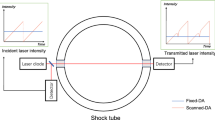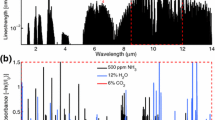Abstract
The recently introduced wavelength-modulation spectroscopy with 1f-phase detection (WMS-\(\theta _{1f}\)) technique showed promising results with potentially improved measurement precision over the popular 1f-normalized WMS-nf (WMS-nf/1f) technique. Like WMS-nf/1f, WMS-\(\theta _{1f}\) enjoys the typical benefits of WMS methods, including low-frequency noise rejection, correction for non-absorbing losses, and insensitivity to the broadband absorption spectra of interfering species. In this work, we performed a detailed analysis of the spectrally resolved scanned-wavelength WMS-\(\theta _{1f}\) measurement technique and its direct comparison against the expected performance of scanned-wavelength WMS-nf/1f and scanned-wavelength direct-absorption spectroscopy (SDAS) measurements. This simulation-based analysis identified specific operating regimes in which the performance of WMS-\(\theta _{1f}\) measurements in terms of accuracy is expected to be greater than the performance of WMS-nf/1f or SDAS. Additionally, improved guidelines for the optimal selection of laser-tuning parameters, including an explicit optimization of the optical scan depth parameter, were developed. Experiments with a CO2 static cell perturbed by a high-speed air jet corroborated the simulation-based findings. Finally, a practical demonstration of a WMS-\(\theta _{1f}\) sensor for measuring temperature and H2O mole fraction in the exhaust of a CH4/air flat-flame burner was presented, with the results confirming model predictions of the superior precision of WMS-\(\theta _{1f}\) relative to WMS-nf/1f and SDAS.
























Similar content being viewed by others
References
R.K. Hanson, Applications of quantitative laser sensors to kinetics, propulsion and practical energy systems. Proc. Combust. Inst. 33(1), 1–40 (2011). https://doi.org/10.1016/j.proci.2010.09.007
C.S. Goldenstein, R.M. Spearrin, J.B. Jeffries, R.K. Hanson, Infrared laser-absorption sensing for combustion flows. Prog. Energy Combust. Sci. 60, 132–176 (2016). https://doi.org/10.1016/j.pecs.2016.12.002
M. Lackner, Tunable diode laser absorption spectroscopy for gas sensing in the process industries—a review. Rev. Chem. Eng. (2007). https://doi.org/10.1515/REVCE.2007.23.2.65
J. Röpcke, G. Lombardi, A. Rousseau, P.B. Davies, Application of mid-infrared tuneable diode laser absorption spectroscopy to plasma diagnostics: a review. Plasma Sour. Sci. Technol. 15(4), S148 (2006)
Z. Wang, P. Fu, X. Chao, Laser absorption sensing systems: challenges, modeling, and design optimization. Appl. Sci. (2019). https://doi.org/10.3390/app9132723
G. C. Mathews, C.S. Goldenstein, Wavelength-modulation spectroscopy for MHz thermometry and H2O sensing in combustion gases of energetic materials. AIAA Scitech Forum, pp. 1–8 (2019)
R.M. Spearrin, C.S. Goldenstein, I.A. Schultz, J.B. Jeffries, R.K. Hanson, Simultaneous sensing of temperature, CO, and CO2 in a scramjet combustor using quantum cascade laser absorption spectroscopy. Appl. Phys. B Lasers Opt. 117(2), 689–698 (2014). https://doi.org/10.1007/s00340-014-5884-0
C.S. Goldenstein, R.M. Spearrin, J.B. Jeffries, R.K. Hanson, Infrared laser absorption sensors for multiple performance parameters in a detonation combustor. Proc. Combust. Inst. 35(3), 3739–3747 (2014). https://doi.org/10.1016/j.proci.2014.05.027
D.D. Lee, F.A. Bendana, S.A. Schumaker, R.M. Spearrin, Wavelength modulation spectroscopy near 5 um for carbon monoxide sensing in a high-pressure kerosene-fueled liquid rocket combustor. Appl. Phys. B Lasers Opt. (2018). https://doi.org/10.1007/s00340-018-6945-6
C. A. Almodovar, D. Salazar, C. L. Strand, R. K. Hanson, R. G. Wright, C. M. Brophy, TDLAS measurements of the underexpanded exhaust plume from a solid propellant gas generator. AIAA Scitech Forum, pp. 1–10 (2019). https://arc.aiaa.org/doi/10.2514/6.2019-0028
W.Y. Peng, R. Sur, C.L. Strand, R.M. Spearrin, J.B. Jeffries, R.K. Hanson, High-sensitivity in situ QCLAS-based ammonia concentration sensor for high-temperature applications. Appl. Phys. B Lasers Opt. 122, 188 (2016). https://doi.org/10.1007/s00340-016-6464-2
W.Y. Peng, S.J. Cassady, C.L. Strand, C.S. Goldenstein, R.M. Spearrin, C.M. Brophy, J.B. Jeffries, R.K. Hanson, Single-ended mid-infrared laser-absorption sensor for time-resolved measurements of water concentration and temperature within the annulus of a rotating detonation engine. Proc. Combust. Inst. 37(2), 1435–1443 (2019). https://doi.org/10.1016/j.proci.2018.05.021
W.Y. Peng, Y. Wang, S.J. Cassady, C.L. Strand, R.K. Hanson, Single-ended sensor for thermometry and speciation in shock tubes using native surfaces. IEEE Sens. J. 19(13), 4954–4961 (2019). https://doi.org/10.1109/JSEN.2019.2903989
C. Yang, L. Mei, H. Deng, Z. Xu, B. Chen, R. Kan, Wavelength modulation spectroscopy by employing the first harmonic phase angle method. Opt. Express 27(9), 12137–12146 (2019). https://doi.org/10.1364/OE.27.012137
A. Upadhyay, M. Lengden, D. Wilson, G.S. Humphries, A.P. Crayford, D.G. Pugh, M.P. Johnson, G. Stewart, W. Johnstone, A new RAM normalized 1f-WMS technique for the measurement of gas parameters in harsh environments and a comparison with 2f/1f. IEEE Photon. J. 10(6), 1–11 (2018)
C. S. Goldenstein, C. L. Strand, I. A. Schultz, K. Sun, J. B. Jeffries, R. K. Hanson, Fitting of calibration-free scanned-wavelength-modulation spectroscopy spectra for determination of gas properties and absorption lineshapes. Appl. Opt. 53(3), 356–367 (2014).
G.B. Rieker, J.B. Jeffries, R.K. Hanson, Calibration-free wavelength-modulation spectroscopy for measurements of gas temperature and concentration in harsh environments. Appl. Opt. 48(29), 5546–5560 (2009). https://doi.org/10.1364/AO.48.005546
J. Reid, D. Labrie, Second-harmonic detection with tunable diode lasers—comparison of experiment and theory. Appl. Phys. B Lasers Opt. 26(3), 203–210 (1981). https://doi.org/10.1007/BF00692448
P. Kluczynski, O. Axner, Theoretical description based on Fourier analysis of wavelength-modulation spectrometry in terms of analytical and background signals. Appl. Opt. 38(27), 5803–5815 (1999)
L.C. Philippe, R.K. Hanson, Laser diode wavelength-modulation spectroscopy for simultaneous measurement of temperature, pressure, and velocity in shock-heated oxygen flows. Appl. Opt. 32(30), 6090–6103 (1993)
C. L. Strand, Scanned wavelength modulation absorption spectroscopy with application to hypersonic impulse flow facilities, Ph.D. dissertation, Stanford University (2014)
R.K. Hanson, R.M. Spearrin, C.S. Goldenstein, Spectroscopy and optical diagnostics for Gases, 1st edn. (Springer, New York, 2015)
K. Sun, X. Chao, R. Sur, C. S. Goldenstein, J. B. Jeffries, R. K. Hanson, Analysis of calibration-free wavelength-scanned wavelength modulation spectroscopy for practical gas sensing using tunable diode lasers. Meas. Sci. Technol. 24(12), 1–12 (2013)
H. Li, G.B. Rieker, X. Liu, J.B. Jeffries, R.K. Hanson, Extension of wavelength-modulation spectroscopy to large modulation depth for diode laser absorption measurements in high-pressure gases. Appl. Opt. 45(5), 1052–1061 (2006)
E. Polak, G. Ribiere, Note sur la convergence de méthodes de directions conjuguées. Revue française d’informatique et de recherche opérationnelle 3(16), 35–43 (1969)
K. Levenberg, A method for the solution of certain non-linear problems in least squares. Quart. Appl. Math. 2(2), 164–168 (1944)
D.W. Marquardt, An algorithm for least-squares estimation of nonlinear parameters. J. Soc. Ind. Appl. Math. 11(2), 431–441 (1963)
W. Wei, W.Y. Peng, Y. Wang, R. Choudhary, S. Wang, J. Shao, R.K. Hanson, Demonstration of non-absorbing interference rejection using wavelength modulation spectroscopy in high-pressure shock tubes. Appl. Phys. B Lasers Opt. 125(9), 1–10 (2019). https://doi.org/10.1007/s00340-018-7118-3
R. Sur, K. Sun, J.B. Jeffries, J.G. Socha, R.K. Hanson, Scanned-wavelength-modulation-spectroscopy sensor for CO, CO2, CH4 and H2O in a high-pressure engineering-scale transport-reactor coal gasifier. Fuel 150, 102–111 (2015). https://doi.org/10.1016/j.fuel.2015.02.003
W.S. Kendal, B. Jørgensen, Tweedie convergence: a mathematical basis for Taylor’s power law, 1/f noise, and multifractality. Phys. Rev. E Stat. Nonlinear Soft Matter Phys. 84(6), 1–10 (2011)
H. Winarto, M. Davis, Fluctuations of density, pressure and temperature in a turbulent mixing region. Proc. R. Soc. Lond. Series A Math. Phys. Sci. 395(1809), 203–228 (1984)
S. J. Cassady, W. Y. Peng, C. L. Strand, J. B. Jeffries, R. K. Hanson, D. F. Dausen, C. M. Brophy, A single-ended, mid-IR sensor for time-resolved temperature and species measurements in a hydrogen/ethylene-fueled rotating detonation engine. AIAA SciTech Forum, pp. 1–8 (2019)
C. S. Goldenstein, R. K. Hanson, Diode-laser measurements of linestrength and temperature-dependent lineshape parameters for H2O transitions near 1.4\(\mu\)m using Voigt, Rautian, Galatry, and speed-dependent Voigt profiles. J. Quant. Spectrosc. Radiat. Transfer. 152, 127–139 (2015)
Acknowledgements
This work was supported by the Office of Naval Research (monitor: Dr. S. Martens) and Innovative Scientific Solutions, Inc. (monitor: Dr. J. Hoke) under Grant no. N00014-15-P-1121. W.Y. Peng was supported by the National Defense Science and Engineering Graduate (NDSEG) Fellowship, 32 CFR 168a awarded by the Department of Defense. The authors would like to thank S.J. Cassady of Stanford University for helpful discussions and recommendations.
Author information
Authors and Affiliations
Corresponding author
Additional information
Publisher's Note
Springer Nature remains neutral with regard to jurisdictional claims in published maps and institutional affiliations.
Rights and permissions
About this article
Cite this article
Peng, W., Strand, C.L. & Hanson, R.K. Analysis of laser absorption gas sensors employing scanned-wavelength modulation spectroscopy with 1f-phase detection. Appl. Phys. B 126, 17 (2020). https://doi.org/10.1007/s00340-019-7369-7
Received:
Accepted:
Published:
DOI: https://doi.org/10.1007/s00340-019-7369-7




